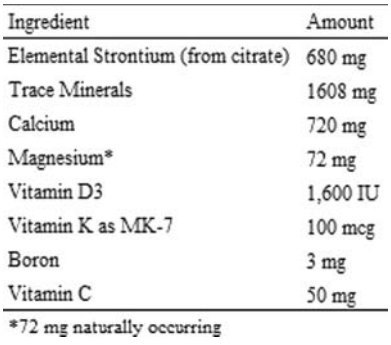Plant-based Calcium probably better than rock-based
Calcium and Vitamin D category contains
{include}
Calcium hazards and bioavailability has the following
{include}
Amazon (US) has >400 plant-based Calcium supplements
Personally, I use the Algae Calcium powder from Amazon I put the powder in a modified salt shaker, and shake in on my morning cereal
Nice 7 year trial of Algae Calcium - 2016
A 7-Year Longitudinal Trial of the Safety and Efficacy of a Vitamin/Mineral Enhanced Plant-Sourced Calcium Supplement
Problems with the study
Not a controlled trial
Great decrease in participants during the trial
Funded by the supplier
But the results are most promising

📄 Download the PDF from VitaminDWiki

Plant Calcium has smaller crystals and is 1.5X more bio-available than synthetic Ca - Sept 2021
Comparative characterization study of plant based calcium versus synthetic calcium
International Journal of Pharmaceutical Chemistry and Analysis
Supriya H Raut1,*, Mihir C Gadani1
1Dept. of Research and Development, Zywie Ventures Pvt. Ltd, Andheri (East), Mumbai, Maharashtra, India
Background: Calcium is an essential mineral which supports bone health as well as serves as a major
therapeutic intervention that can prevent and delay the incidence of osteoporosis. Multicellular aquatic
plants like Lithothamnion calcareum are a rich source of plant based calcium.
Aims/Objective: To characterize Plant based calcium and Synthetic calcium sources using sophisticated
analytical techniques.
Material and Methods: Plant based Calcium and Synthetic Calcium sources were subjected to
instrumental analysis such as SEM, ICP-OES and XRD, and comparisons were done followed by
interpretation.
Results and Discussion: In this study, three different instrument techniques like SEM, ICP-OES and XRD were used for the characterization of plant based calcium and synthetic calcium. The results showed that plant based calcium were smaller isotropic crystals as compared to synthetic calcium crystals which were larger and anisotropic. Further, in case of XRD results, plant based calcium is shown to possess two 2θ values, whereas in case of synthetic calcium, it showed a single 2θ value. Further, Magnesium and Boron content were higher in case of plant based calcium as compared to synthetic calcium.
Conclusion: Both Plant based and Synthetic Calcium can be distinguished using SEM, ICP-OES and XRD techniques. Outcomes of this study enlightens the probable reasons for enhanced bioavailability in case of plant based calcium sources as compared to synthetic calcium sources.
